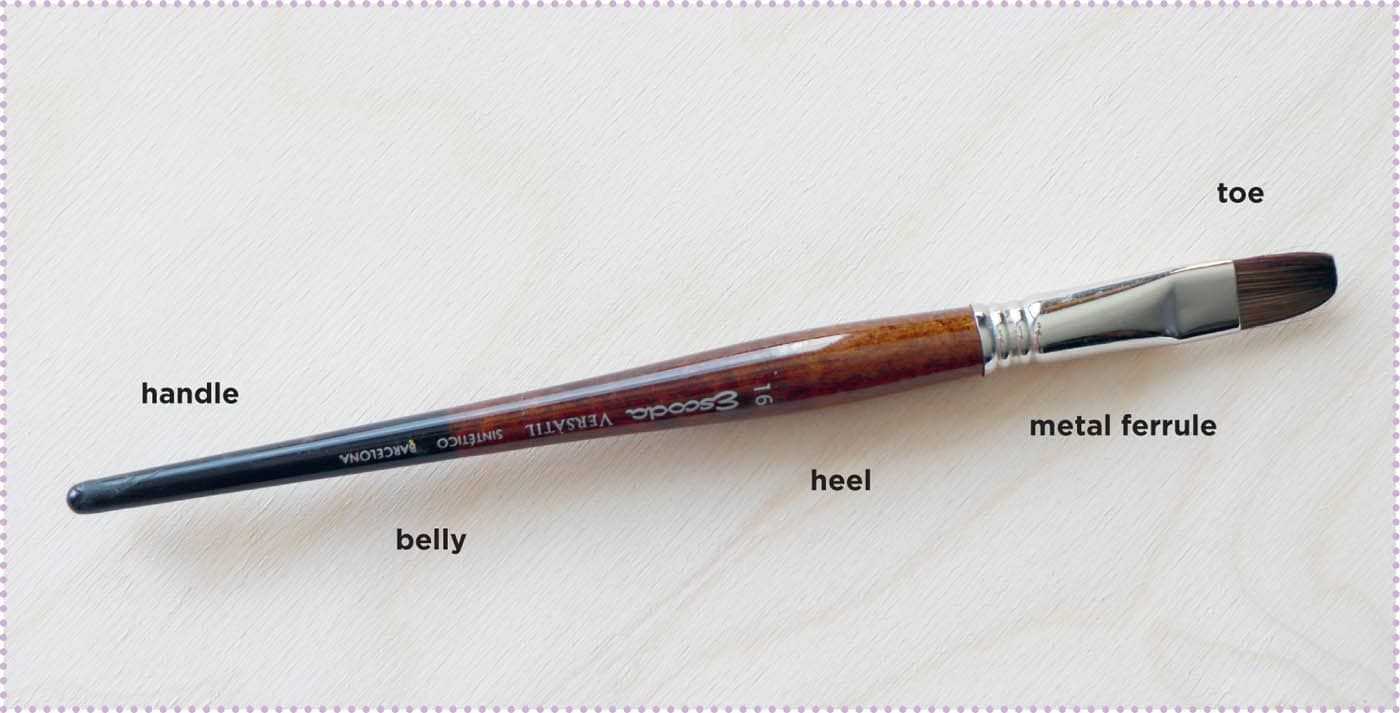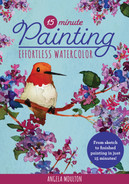Tools & Materials
One of the keys to quick painting is to have your supplies gathered and ready to go before you begin. Organization and cleanliness are important for a pleasant and joyful experience. The following pages include some tips for creating the perfect environment for effortless watercolor painting.

In this book, the projects are painted on watercolor paper. There are other options, such as watercolor panels and stretched canvas; however, we will concentrate on using watercolor paper. Watercolor papers come in different weights, sizes, and textures. They also come in different formats, such as sketchbooks, blocks, or loose sheets and rolls. Paper weight is usually measured in pounds. The heavier the weight, the thicker the paper. A heavier paper is a good choice when using lots of washes of paint. Thinner or lighter-weight papers are usually the smoothest papers. They are more likely to buckle and ripple with large amounts of water. Thinner papers may need to be taped down or stretched.SURFACES

Watercolor blocks are pads that are bound on all four sides, which prevents the paper from buckling. Once the painting is dry, insert a flat palette knife under the top sheet of paper and gently slide along the edges to remove it from the block. A watercolor sketchbook is portable and great for painting on-the-go. Because the paper is not taped or fastened on the edges, the paper can only take small amounts of paint. Otherwise, the pages may ripple or curl at the edges. Watercolor pads are similar to sketchbooks as they are fastened at one end. Like a sketchbook, smaller-sized pads are great for traveling or outdoor painting. Use your finger to remove air bubbles and prevent seepage.WATERCOLOR BLOCKS
SKETCHBOOKS & PADS

Loose watercolor paper sheets should be taped down to prevent rippling. I use a maple plywood board as my support. Maple and birch plywood are great because they can absorb large quantities of water without warping. You can use washi tape, masking tape, or paper kraft tape to attach the paper to your support. Some other support options are watercolor panels, rolls, and canvas. If you want to explore more options for painting surfaces, these are great places to start. Tape along all four sides to secure the paper to the watercolor board.WATERCOLOR PAPER

Watercolor paper comes in different textures. The size and type of artwork, as well as the amount of washes of paint, should determine what kind of paper to use. Hot-pressed paper is very smooth and usually lighter in weight than cold-pressed paper. The paper has been pressed with heat, resulting in a smooth surface. Hot-pressed paper is suitable for smaller works, fine-detailed work, and especially portraits. I say “smaller” works because it is thinner and more likely to buckle, but it can be stretched for larger sizes. Cold-pressed paper has a rougher texture and is heavier than hot-pressed paper. There is a definite tooth to the paper that absorbs more paint and water. Cold-pressed paper is suitable for many types of artwork, from landscapes to figures. I think it is the most adaptable of all the watercolor papers. Rough paper is the roughest paper, with a definite and pronounced tooth. It is great for large washes of paint and for landscapes where a rough texture adds depth to the foliage and atmosphere.PAPER TEXTURE


Watercolor brushes are made especially for use with watercolor paints. They come in both natural and synthetic bristle. The handle is usually either wood or metal. Brushes can be super soft or stiff and coarse. Brush handles can be long or short. The brush is made up of a handle; the metal ferrule, which is crimped where the bristles are fastened; then the heel (closest to the metal ferrule), belly, and toe (tip) of the brush. Brushes come in many different shapes and sizes. Sizes are numbered from 20/0 to 30+. There are a few rare specialty brushes finer or larger than these, but above are the most common sizes. In general, medium and smaller brushes are good for these projects because they are easy to use and adaptable to all the projects. I suggest a smaller brush for detail work and medium brush or two for larger and broader strokes. Small and extra-small brushes are great for detail work. Medium brushes are adaptable for most items painted in this book. Large brushes are used for preparing large areas with washes of color. Long handles are great for working on large projects or on an upright easel. Short handles are good for smaller projects, detail work, and working on a flat surface.BRUSHES

Watercolor paint brushes come in flat, bright, round, liner, mottler, fan, filbert, and other shapes. For this book, you really only need a couple of flat or bright brushes and a small round brush. Flat brushes are flat and wide with an even tip. They are great for large washes of paint. The thin edge is good for painting straight edges and for some detail work. Bright brushes are similar to flat brushes but are shorter in length. They are good for more detailed and controlled work and for loading large amounts of paint onto an area of your painting. Round brushes are round in shape at the ferrule, usually with a pointed tip. They are great for washes of paint and detail work. Liner brushes are round in shape with longer bristles. The liner brush is great for long lines and hand lettering. Mop brushes are round in shape with a thick bunch of bristles. This brush is appropriate for large washes of color.BRUSH SHAPES





